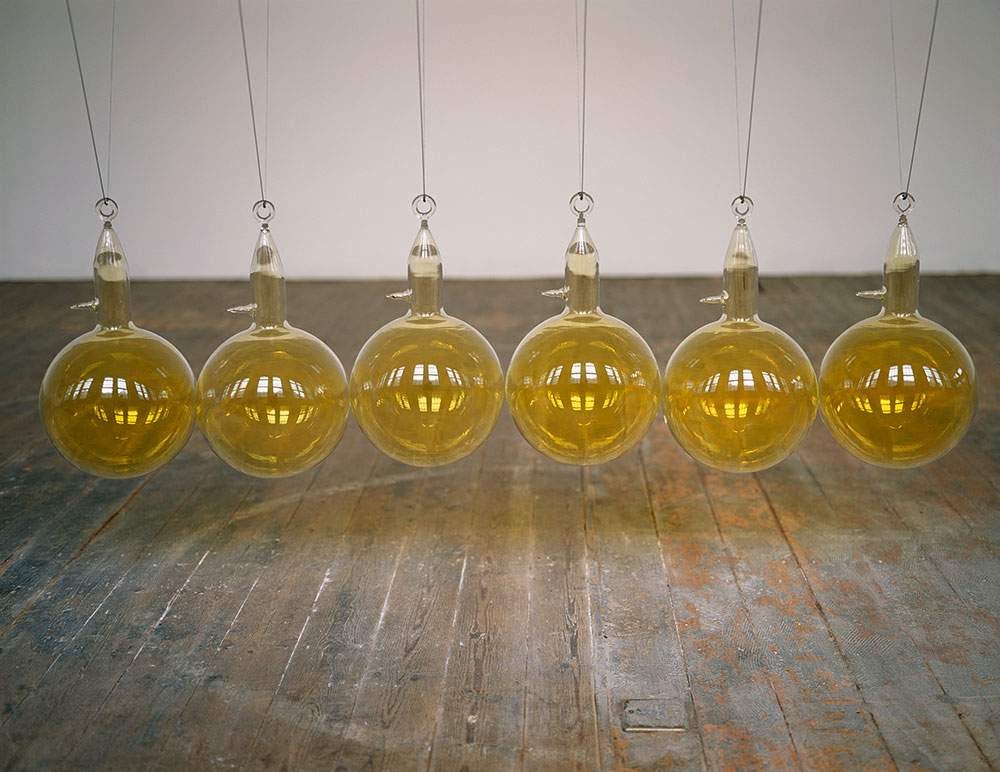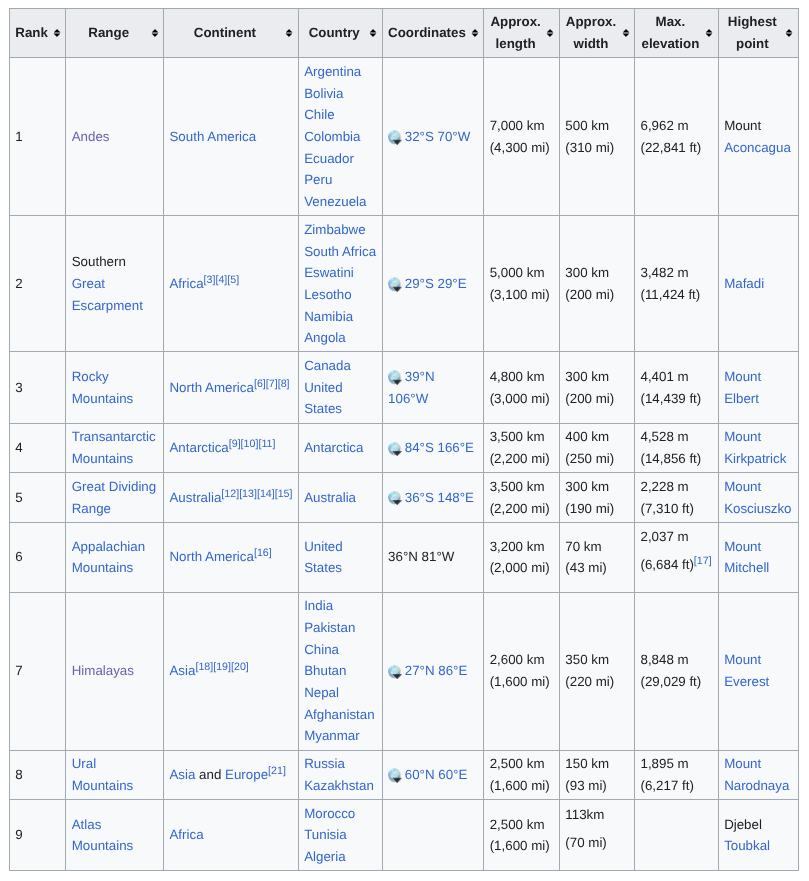In Praise of Curation
This week: a self-interested defence of someone just showing you the good stuff. Also: the longest mountain chain on earth; and what is a stink pipe?
A few weeks ago, I saw a piece of art I have been unable to stop thinking about since. Hamad Butt’s Cradle consists of a giant, immobilised Newton’s Cradle, a sort of executive desk toy popular in the ‘80s. In this version, though, it’s not five metal spheres that are hung in a line, so that a force at one end of the line causes the sphere at the other to move: its sealed glass baubles, each filled with lethal yellow chlorine gas. All the time I was in the room containing the work and looking at its companion pieces, Hypostasis and Ladder – the three make up a 1992 trilogy called Familiars – I was constantly aware of Cradle, and the low but constant itch to abandon my caution and all good sense and set it into motion.
If I tell you that Butt died in 1994 of complications from AIDS, you might get a sense of what the piece is trying to say, and why weeks later I still find myself thinking of the brilliance of that metaphor.

The matter I’m concerned with today, though, isn’t really about Hamad Butt or the AIDS-crisis or even art, a subject of which, for all my enthusiasm, I know very little. The key thing here is this: I knew nothing of Hamad Butt when I walked into that room. We chose to go because the Whitechapel Gallery is a short walk from my flat, and this exhibition is what happened to be on so we bought two tickets.
One of the handful of art exhibitions I suspect I will remember forever1 is something I only saw because we wanted to see some art, and somebody I will never meet said, “Hey, look at this – it’s good.”
I’ve been thinking about all this after reading this interview with the writer/performer Mark Gatiss, intended to promote his new series, Bookish.2 “I was devoted to television,” he told the Big Issue. “I watched so much, and it was a huge osmotic process. I took in so much about history, science, film, sex, society. That’s what television still does at its best – it informs, educates and entertains.”
I’m half a generation younger than Gatiss, so I’m aware we grew up in very different television environments – but that sentiment is something that resonates with me, nonetheless. Television was my window into music and comedy, a way of learning about recent history and its changing culture and social mores alike. I had access to a lot more channels and, via videos, WHSmith and UK Gold a lot more of the recent past was in reach for me than it would have been for Gatiss. Nonetheless, my explorations were to some extent guided, not just by a kindly grandfather who thought I should really know the work of Will Hay or Kenneth Horne, but by TV schedulers, too. They weren’t always saying “Hey, this is good” – by the mid 1990s there were enough hours to fill that they were quite often saying, “Hey, this is on” – but all the same there was an element of curation.
I sometimes wonder if the easy availability of essentially all human culture thanks to the internet and streaming means we’re in danger of losing that. Perhaps it’s just me, but I’ve sometimes found that functionally infinite choice makes me less likely to explore, to try new things instead of those that sort of rhyme with the ones I already know. An algorithm is always going to nudge you towards things like the things it already knows you enjoy: it’s less likely to push you out of your comfort zone, to say, “Hey, try this – it’s important, and you might like it.” But just as you’re more likely to encounter new writers and ideas when someone bundles a bunch of them together and calls it a magazine, so there is no better way of encountering new culture than being forced to try something because it is there, and there aren’t many other options. Sometimes, you just need to get stuck in.
I don’t want to be too “it were all better in my day” about this: the greater difficulty of getting hold of the things you did want to see was one of the smallest ways in which it clearly wasn’t, and one of the main reason for any generation to say “These Things Are The Things That Matter” is so the next can reply “Are They Bollocks”. But nonetheless, these limitations forced me down avenues I would not otherwise have taken. Like Gatiss, I took in so much.
A few weeks ago, when I was buying books for my holiday – always the most fun part of holiday prep, that – I wrote a list of novelists whose work I’d enjoyed in the past, on the risk-averse grounds I could be confident I’d enjoy more of the same. And then, thankfully, I entirely ignored it. A couple of the books I read were chosen because I found them on shelves and they grabbed me; others because they were being pushed at me by bookshops, either as ~important recent works~ or things that were by the counter and helpfully short. (If I didn’t enjoy them, at least they’d be quick.) In this way I found myself reading books that don’t normally belong together, spotting connections and considering ideas – about who tells stories, what counts as talent, what makes someone who they are – I otherwise would not have encountered.
The one that stays with me most, though, was a book I encountered through none of those routes. Trespasses by Louise Kennedy is a novel about love and infidelity set in Northern Ireland in 1975. I would never have picked it up of my own accord – I don’t generally care for love stories, doomed or otherwise, and have not read much about the Troubles. But it’s the best book I’ve read this year.
And I read it because someone – the same someone who I went to the Whitechapel Gallery with, as it happens – picked it off the shelf, put it in my hands and said, “Read this. It’s good.”
If you are in the East End of London, by the way, Hamad Butt: Apprehensions runs until 7 September. You can read more about him in this piece by Elizabeth Fullerton in the Guardian here.
And now, some more things, which I have taken the liberty of curating for you.
Earth’s secret 60,000km mountain range
Every child knows that Everest is the tallest mountain on the planet. Every slightly nerdy child probably also knows that this title has sometimes been challenged by K2, and that both anyway look tiny compared to Olympus Mons, which would get the title easily if someone hadn’t been stupid enough to build it on Mars.
But there’s more than one measure of comparing scale in mountains, so here’s a different question: what’s the longest mountain range?
Wikipedia, as so often, has a helpful chart – which, for reasons I am not entirely clear on, contains the top nine. On that, the Himalayas are all the way down in seventh place, beneath the Rockies and Appalachians, plus a few ranges I was barely even aware of. (In one case, to be fair, it’s because they’re hiding under quite a lot of snow.)3
At any rate: looking at this chart, you’d assume, quite reasonably, that the longest mountain chain in the world is the Andes, the 7,000km range which stretches pretty much the entire length of South America and justifies giving Chile that extremely stupid shape.
But no: I’ve tricked you. Because there’s another mountain range, even better hidden than the Transantarctic. Because it’s under water.
Keep reading with a 7-day free trial
Subscribe to The Newsletter of (Not Quite) Everything to keep reading this post and get 7 days of free access to the full post archives.

